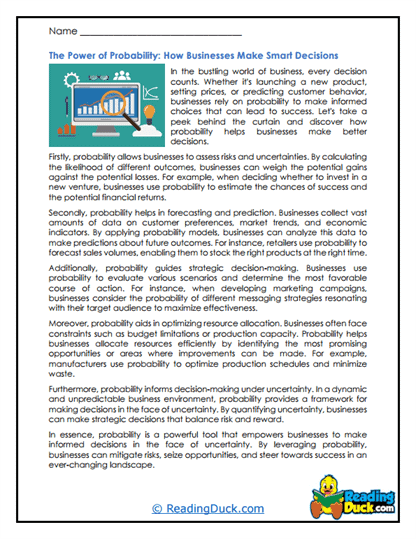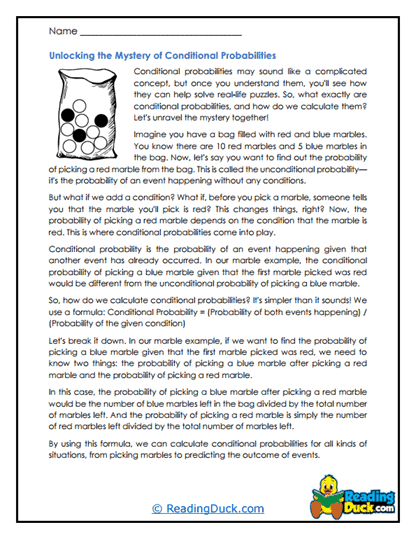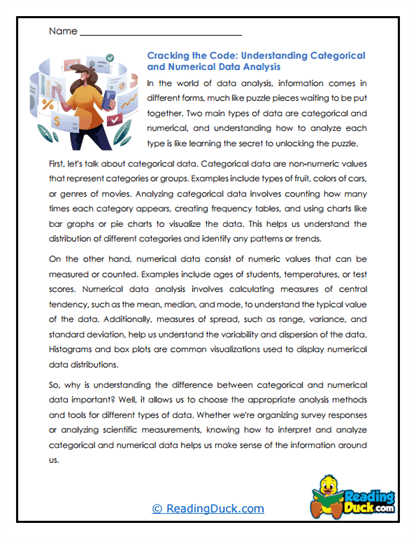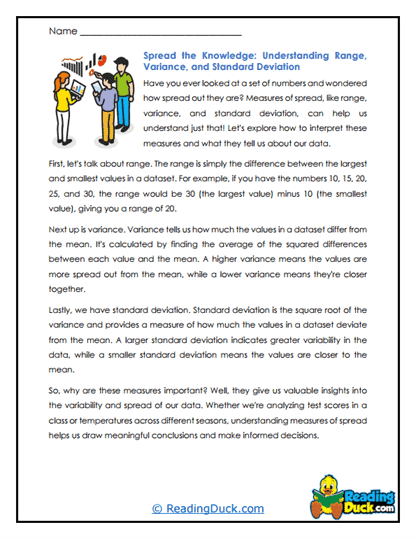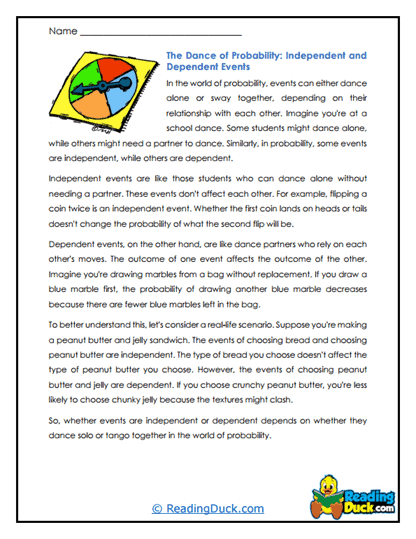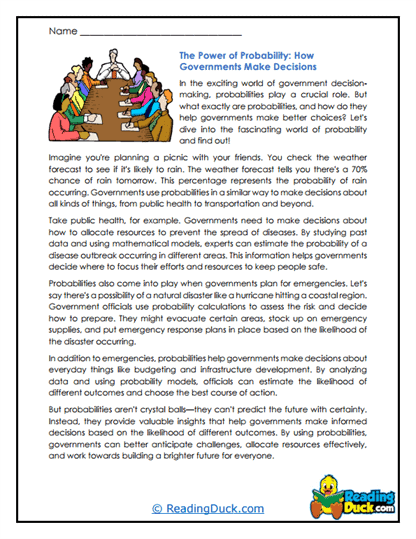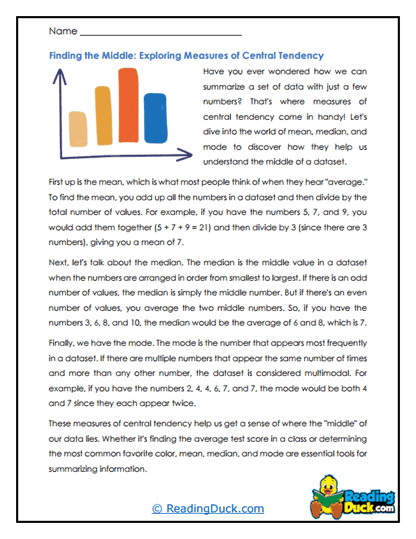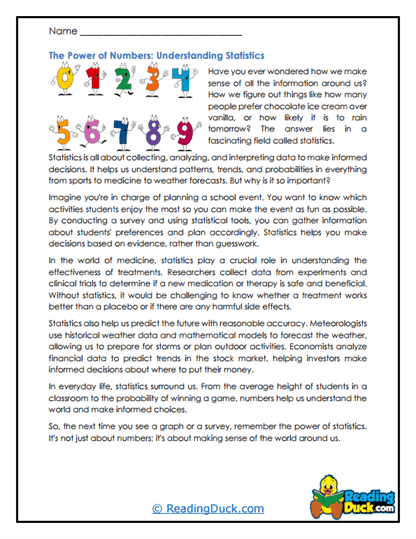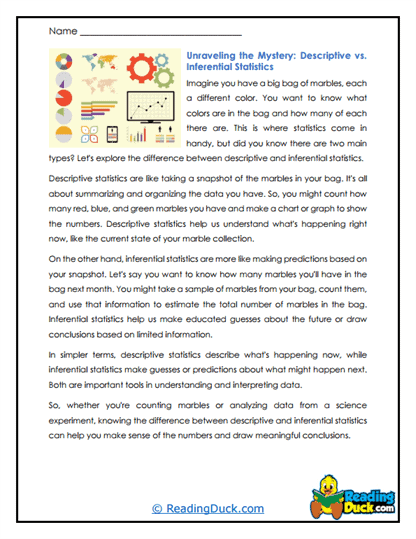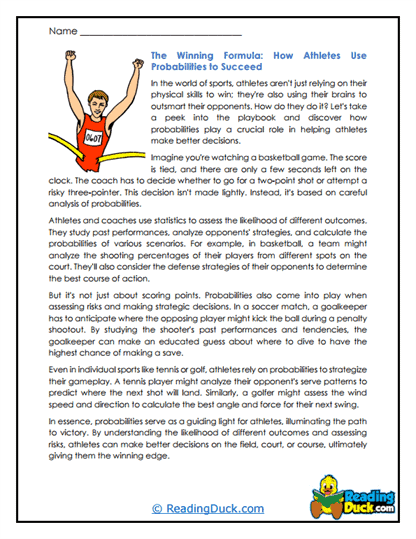Statistics and Probability Worksheets
About Our Statistics and Probability Worksheets
Our Statistics and Probability worksheets provide a thorough and engaging exploration of key concepts that are essential for understanding and analyzing data in the real world. These worksheets cover a wide range of topics, from basic probability to more complex statistical analyses, making them an invaluable resource for students who want to develop strong analytical skills.
Each category within our Statistics and Probability collection contains several worksheet sets, each focusing on a specific aspect of the topic. These sets are designed to gradually build students' knowledge and confidence. Each worksheet set includes:
- Multiple Choice Questions: These questions assess students’ understanding of core concepts such as calculating probabilities, interpreting data sets, and understanding statistical measures like mean, median, and mode. This format helps students reinforce their knowledge through focused practice.
- Short Answer Questions: This format challenges students to solve problems and explain their reasoning in their own words. These questions encourage critical thinking and help students develop a deeper understanding of statistics and probability.
- Open-Ended Questions: These questions invite students to explore statistical and probabilistic ideas more creatively, asking them to express their personal input, opinions, or preferences related to the topics they have studied. Engaging with open-ended problems allows students to connect more deeply with the material and think critically about real-world data.
Each worksheet set is designed to assess students’ understanding while fostering a deeper connection to the material. An answer key is provided for every question sheet, ensuring that educators can easily review students’ progress. All worksheets are available as PDF files, which can be easily viewed electronically, downloaded, and printed.
Understanding Data and Chance: An Introduction to Statistics and Probability
Statistics and Probability are essential branches of mathematics that allow us to make sense of data and understand the likelihood of events. When teaching these topics, it’s important to emphasize how they apply to real-world situations and how they help us make informed decisions based on data.
Key Aspects of Statistics and Probability:
- Introduction to Probability: Probability is the study of how likely events are to occur. It provides a mathematical framework for predicting the outcomes of random processes. In this section, students learn about basic probability concepts, including the calculation of simple probabilities, understanding probability as a fraction or percentage, and exploring probability through experiments and simulations.
- Counting Principles and Combinatorics: Counting principles, such as permutations and combinations, are essential for calculating probabilities in more complex situations. Students learn how to apply these principles to determine the number of possible outcomes in a scenario, which is crucial for understanding probability distributions and making predictions.
- Descriptive Statistics: Descriptive statistics involve summarizing and describing data sets using measures such as mean, median, mode, range, and standard deviation. These concepts help students understand how data is distributed and what the central tendencies and variability of the data tell us about a particular situation.
- Data Representation: In this section, students explore various ways to represent data visually, including histograms, bar graphs, pie charts, box plots, and scatter plots. Understanding how to interpret and create these representations is essential for analyzing and communicating data effectively.
- Probability Distributions: Probability distributions describe how probabilities are distributed over different outcomes. Students learn about common probability distributions, such as the binomial distribution and normal distribution, and how to use these distributions to model real-world scenarios.
- Inferential Statistics: Inferential statistics allow us to make predictions or inferences about a population based on a sample of data. This section introduces students to concepts like confidence intervals, hypothesis testing, and the use of statistical tests to determine the significance of results.
- Correlation and Regression: Students learn about the relationship between two variables through correlation and regression analysis. These concepts help students understand how one variable might predict or influence another, which is useful for making informed decisions in various fields such as economics, biology, and social sciences.
- Experimental Design and Sampling Methods: Understanding how to design experiments and select appropriate samples is crucial for collecting reliable data. In this section, students explore different sampling methods, learn how to avoid bias, and understand the importance of randomization in experimental design.
By exploring these key aspects of statistics and probability, students can develop strong analytical skills that are essential for making sense of data in the real world. Statistics and Probability are not just about numbers—they are about understanding patterns, making predictions, and making informed decisions based on data.
Examples of Real-World Applications
Statistics and Probability are not just theoretical concepts; they have many practical applications that are critical for various fields. Here are some examples of how statistics and probability are used in the real world:
- Weather Forecasting: Meteorologists use probability and statistical models to predict weather patterns. By analyzing historical data and current conditions, they can estimate the likelihood of different weather events, such as rain or snow.
- Healthcare and Medicine: In healthcare, statistics are used to analyze patient data, track the spread of diseases, and determine the effectiveness of treatments. Probability is crucial in clinical trials to assess the likelihood that a new drug or treatment will have a beneficial effect.
- Business and Economics: Businesses use statistical analysis to make informed decisions about marketing, production, and investment. Probability models help companies assess risks, forecast demand, and optimize pricing strategies.
- Sports Analytics: In sports, statistics are used to evaluate player performance, develop strategies, and predict the outcomes of games. Probability models are also used in sports betting and fantasy sports to estimate the likelihood of various outcomes.
- Quality Control: Manufacturing companies use statistics to monitor product quality and ensure that production processes meet standards. Statistical process control involves using data to detect variations in the production process and make necessary adjustments.
- Polls and Surveys: Polling organizations use statistics to analyze survey data and make predictions about public opinion, election outcomes, and social trends. Probability sampling methods help ensure that survey results are representative of the broader population.
- Insurance and Risk Management: Insurance companies use probability and statistics to assess risks and determine premiums. By analyzing data on accidents, health conditions, and other factors, they can estimate the likelihood of different events and set prices accordingly.
- Education: In education, statistics are used to assess student performance, evaluate the effectiveness of teaching methods, and conduct research on educational outcomes. Probability helps in analyzing test scores, predicting student success, and making data-driven decisions in education policy.
These examples show that statistics and probability are powerful tools that influence many aspects of our lives. They help us make sense of complex data, predict outcomes, and make informed decisions in various fields.
Using These Worksheets in Class
To get the most out of our Statistics and Probability worksheets, teachers and parents can incorporate them into their lessons in a variety of effective and creative ways. Here are some tips for using these worksheets in the classroom or homeschool setting:
Connect Math to Real Life:
- Contextual Learning: Relate statistics and probability concepts to real-world situations that are relevant to students’ lives. For example, when teaching about probability, discuss how these concepts are used in weather forecasting or sports analytics. Making these connections helps students see the value of statistics and probability in their everyday lives.
- Problem-Solving Challenges: Use the worksheets to introduce real-world problems that require statistical analysis or probability calculations to solve. This approach not only reinforces students’ understanding but also challenges them to think critically and apply their knowledge in practical ways.
Encourage Collaborative Learning:
- Group Work: Assign worksheets as group activities where students can work together to solve statistical problems and discuss their approaches. Collaborative learning encourages students to share ideas, clarify their understanding, and learn from one another.
- Data Projects: Incorporate the worksheets into larger data projects that require students to collect, analyze, and interpret data. These projects allow students to see how different statistical concepts work together and how they can be applied creatively to solve real-world problems.
Incorporate Technology:
- Digital Tools: If students have access to computers or tablets, complement the worksheets with digital tools that allow them to explore statistics and probability concepts interactively. Online graphing tools, probability simulators, and data analysis software can help students visualize data and perform complex calculations more easily.
- Virtual Learning: In a homeschool or remote learning setting, use virtual classrooms or online platforms to assign and review the worksheets. This allows for immediate feedback and interactive discussion, making the learning experience more dynamic.
Foster a Positive Math Environment:
- Celebrate Progress: Regularly acknowledge and celebrate students’ progress as they work through the statistics and probability worksheets. Whether through verbal praise, certificates, or a progress chart, recognizing their efforts can boost motivation and confidence.
- Encourage a Growth Mindset: Promote a growth mindset by reminding students that making mistakes is a natural part of the learning process. Encourage them to view challenges as opportunities to grow and develop their skills in statistics and probability.
Adapt to Individual Learning Needs:
- Differentiated Instruction: Use the variety of worksheets to differentiate instruction based on students’ individual needs. For students who need more practice, offer additional worksheets on fundamental concepts like calculating mean or understanding probability. For advanced students, provide more challenging problems that require higher-order thinking and complex data analysis.
- Personalized Feedback: When reviewing completed worksheets, provide personalized feedback that guides students in improving their understanding. Highlight what they did well and offer constructive suggestions for areas where they can improve.
By using these strategies, teachers and parents can help students develop a strong understanding of statistics and probability and build the confidence they need to succeed in math. The Statistics and Probability worksheets are a valuable resource that can be used in flexible and creative ways to support learning, making these topics accessible and engaging for all students. Through consistent practice and exploration of real-world applications, students will not only master statistical and probabilistic concepts but also appreciate their relevance and importance in everyday life.
